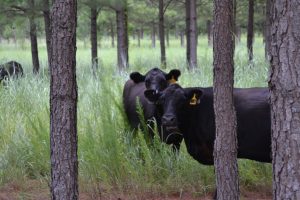By Mike Beacom
This blog post is from The National Association of Conservation Districts and can be found in its original form here.
Dr. Alan Franzluebbers didn’t go looking for silvopasture; the practice was waiting for him. The research ecologist relocated four years ago to a position with North Carolina State University’s Department of Soil Science. Having researched pasture systems for more than a decade in Georgia, Franzluebbers inherited a silvopasture study already underway at the Center for Environmental Farming Systems in Goldsboro.
Silvopasture is one of five recognized agroforestry practices. It combines trees with forage and livestock production. The trees are managed for high-value sawlogs and, at the same time, provide shade and shelter for livestock and forage, reducing stress and sometimes increasing forage production.
The 17-acre demonstration site in Goldsboro incorporates longleaf pine, loblolly pine, and cherrybark oak across a mixture of soil types. Trees are planted in three-row sets, with 6-foot by 6-foot diamond spacing. Trees were planted on the site in 2007, but livestock grazing was incorporated just this year.
 Silvospasture relies on many familiar strategies. “Rotational grazing is one key to success, even more so than traditional pasture operations. The danger is animals exposing trees by rubbing and denuding the area below the trees,” he said.
Silvospasture relies on many familiar strategies. “Rotational grazing is one key to success, even more so than traditional pasture operations. The danger is animals exposing trees by rubbing and denuding the area below the trees,” he said.
Franzluebbers presented his study’s initial findings to the NACD Forestry Resource Policy Group (RPG) in Cherokee, North Carolina, in early August. According to a 2014 NACD forestry survey, 21 percent of responding districts in the Southeast Region – more than double in any other region – indicated they were assisting landowners with silvopasture. According to Franzluebbers, that’s likely because in many areas of the Southeast, including the coastal plains, land is too wet or too dry for optimal agricultural operations and landowners are more open to exploring ways to maximize land use.
There is opportunity for conservation districts to expand landowner engagement in silvopasture – not only in the Southeast, but in other regions – based on shifting land use and landowner interests.
“Silvopasture management is not for everyone,” says Rich Straight, technology transfer leader for the National Agroforestry Center. “It does require practical knowledge about a variety of management activities on pine trees, rotational grazing, livestock condition, and forage quality.” However, for beginning farmers and those trying to make a living on smaller land holdings, silvopastures can generate more income than more common management strategies.
For example, “Pine plantations can provide a good return on investment,” he continued. “The downside is one of cash flow because income is realized only every 10 to 15 years. On the other hand, commodity crops like corn and soybeans have a small profit margin, which requires quite a few acres to generate enough income to support a family. By combining an annual source of forage or livestock income with the longer term timber income, producers can generate more income per acre.”
The Center for Environmental Farming Systems now hosts tours for local landowners. “Many of those who attend walk away impressed (and) some… consider starting their own silvopasture operation on a small scale,” says Franzluebbers.
Still, same as Straight, Franzluebbers admits it’s a select audience. “It’s not for everyone,” he says, “but it is an opportunity for producers interested in conservation. Silvopasture, like other agroforestry practices, allows an opportunity to work the land and meet conservation goals. It helps us achieve an enriched landscape.”
For more information on this operation, email Dr. Alan Franzluebbers at alan.franzluebbers@ars.usda.gov.

